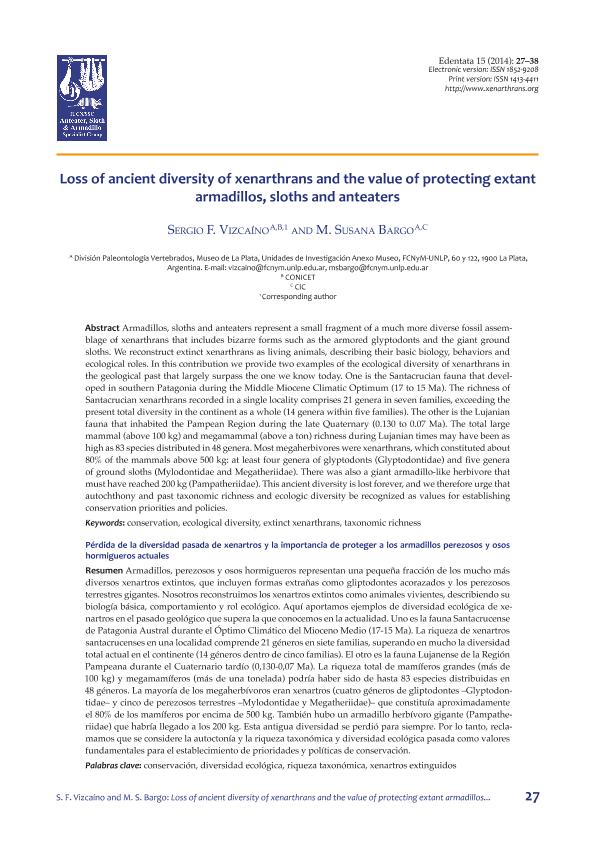Artículo
Armadillos, sloths and anteaters represent a small fragment of a much more diverse fossil assemblage of xenarthrans that includes bizarre forms such as the armored glyptodonts and the giant ground sloths. We reconstruct extinct xenarthrans as living animals, describing their basic biology, behaviors and ecological roles. In this contribution we provide two examples of the ecological diversity of xenarthrans in the geological past that largely surpass the one we know today. One is the Santacrucian fauna that developed in southern Patagonia during the Middle Miocene Climatic Optimum (17 to 15 Ma). The richness of Santacrucian xenarthrans recorded in a single locality comprises 21 genera in seven families, exceeding the present total diversity in the continent as a whole (14 genera within five families). The other is the Lujanian fauna that inhabited the Pampean Region during the late Quaternary (0.130 to 0.07 Ma). The total large mammal (above 100 kg) and megamammal (above a ton) richness during Lujanian times may have been as high as 83 species distributed in 48 genera. Most megaherbivores were xenarthrans, which constituted about 80% of the mammals above 500 kg: at least four genera of glyptodonts (Glyptodontidae) and five genera of ground sloths (Mylodontidae and Megatheriidae). There was also a giant armadillo-like herbivore that must have reached 200 kg (Pampatheriidae). This ancient diversity is lost forever, and we therefore urge that autochthony and past taxonomic richness and ecologic diversity be recognized as values for establishing conservation priorities and policies Armadillos, perezosos y osos hormigueros representan una pequeña fracción de los mucho más diversos xenartros extintos, que incluyen formas extrañas como gliptodontes acorazados y los perezosos terrestres gigantes. Nosotros reconstruimos los xenartros extintos como animales vivientes, describiendo su biología básica, comportamiento y rol ecológico. Aquí aportamos ejemplos de diversidad ecológica de xenartros en el pasado geológico que supera la que conocemos en la actualidad. Uno es la fauna Santacrucense de Patagonia Austral durante el Óptimo Climático del Mioceno Medio (17-15 Ma). La riqueza de xenartros santacrucenses en una localidad comprende 21 géneros en siete familias, superando en mucho la diversidad total actual en el continente (14 géneros dentro de cinco familias). El otro es la fauna Lujanense de la Región Pampeana durante el Cuaternario tardío (0,130-0,07 Ma). La riqueza total de mamíferos grandes (más de 100 kg) y megamamíferos (más de una tonelada) podría haber sido de hasta 83 especies distribuidas en 48 géneros. La mayoría de los megaherbívoros eran xenartros (cuatro géneros de gliptodontes —Glyptodontidae— y cinco de perezosos terrestres —Mylodontidae y Megatheriidae)— que constituía aproximadamente el 80% de los mamíferos por encima de 500 kg. También hubo un armadillo herbívoro gigante (Pampatheriidae) que habría llegado a los 200 kg. Esta antigua diversidad se perdió para siempre. Por lo tanto, reclamamos que se considere la autoctonía y la riqueza taxonómica y diversidad ecológica pasada como valores fundamentales para el establecimiento de prioridades y políticas de conservación.
Loss of Ancient Diversity of Xenarthrans and the Value of Protecting Extant Armadillos, Sloths and Anteaters
Título:
Pérdida de la diversidad pasada de xenartros y la importancia de proteger a los armadillos perezosos y osos hormigueros actuales
Fecha de publicación:
11/2014
Editorial:
Anteater
Revista:
Edentata
ISSN:
1413-4411
Idioma:
Inglés
Tipo de recurso:
Artículo publicado
Clasificación temática:
Resumen
Palabras clave:
Conservation
,
Ecological Diversity
,
Extinct Xxenarthrans
,
Taxonomic Richness
Archivos asociados
Licencia
Identificadores
Colecciones
Articulos(CCT - LA PLATA)
Articulos de CTRO.CIENTIFICO TECNOL.CONICET - LA PLATA
Articulos de CTRO.CIENTIFICO TECNOL.CONICET - LA PLATA
Citación
Bargo, María Susana; Vizcaíno, Sergio Fabián; Loss of Ancient Diversity of Xenarthrans and the Value of Protecting Extant Armadillos, Sloths and Anteaters; Anteater; Edentata; 15; 11-2014; 27-38
Compartir
Altmétricas




